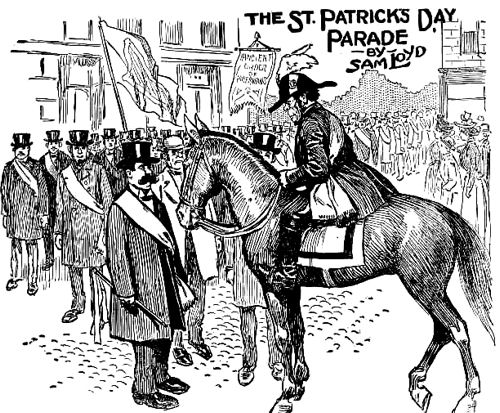



CONCERNING THE RECENT St. Patrick's Day parade an interesting and curious puzzle developed which bids fair to become famous. The Grand Marshall issued the usual notice setting forth that “the members of the Honorable and Ancient Order of Hibernians will parade in the afternoon if it rains in the morning, but will parade in the morning if it rains in the afternoon,” which gave rise to the popular impression that rain is to be counted as a sure thing on St. Patrick's Day. Casey boasted that he “had marched for a quarter of a century in every St Patrick's day parade since he had become a boy.”
I will pass over the curious interpretations which may be found to the above remark, and say that old age and pneumonia having overtaken Casey at last, he had marched on with the immortal procession. And when the boys met again to do honor to themselves and St Patrick on the 17th of March, they found that there was a vacancy in their ranks which it was difficult to fill. In fact, it was such an embarrassing vacancy that it broke up the parade and converted it into a panic stricken funeral procession.
The lads, according to custom, arranged themselves ten abreast, and did march a block or two in that order with but nine men in the last row where Casey used to walk on account of an impediment in his left foot. The music of the Hibernian band was so completely drowned by the calls regarding what had become of “the little fellow with the limp,” that it was deemed best to reorganize upon the basis of nine men to the row, as eleven would not do.
But again was Casey missed. And the procession halted when it was discovered that the last row came out with but eight men. There was a hurried attempt to form with eight men in each row; again with seven, and then with five, four, three and even two, but it was found that each and every formation always came out with a vacant space for Casey in the last line. Then, although it strikes us as a silly superstition, it became whispered through the lines that every time they started off, Casey's "dot and carry one" step could be heard, and the boys were so firmly convinced that Casey's ghost was marching that no one was bold enough to bring up the rear.
The grand marshal, however, was a quick-witted fellow, who speedily laid out that ghost by ordering the men to march in single file, so, if Casey did follow in spirit, he brought up the rear of the longest procession that ever did honor to his patron saint.
The question involved in this puzzle is to determine just how many men there must have been in the procession. It is a pretty problem which will interest the young folks despite of its going somewhat into simple arithmetic, which many object to out of school hours.
In the story of the great parade it was told that when the men attempted to march with any number of men —from two to ten—in a row, there was always a vacant space left where Casey used to walk. Now all of our young puzzlists know how to find the least common multiple of 2, 3, 4, 5, 6, 7, 8, 9 and 10, but that vacancy of one puzzles them, because it took them away from the rules of their books. Nevertheless, it is plain arithmetic and yields readily to a little reasoning, 2,520 is the least common multiple of 2, 3, 4, 5, 6, 7, 8, 9 and 10, and may be divided by any of those numbers, hence that must have been the original number of members, when Casey was alive. Take away the one man and attempt to arrange the parade with any number of men from 2 to 10 abreast, and it is plain to be seen that the last row will always be short just one man, so it is obvious that the correct answer would be 2,519 men if it were not for that puzzle catch where it said: “As eleven would not do.” For 2,519 men could he divided by 11, so we will have to give 5,039 as the correct number of men who could not be divided into rows from 2 to 11.
[Page 25]